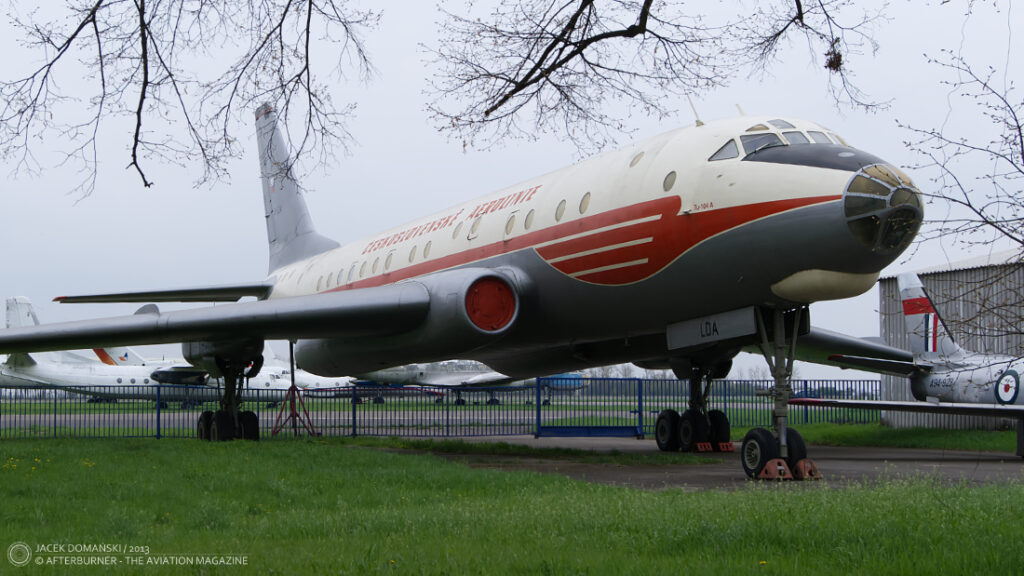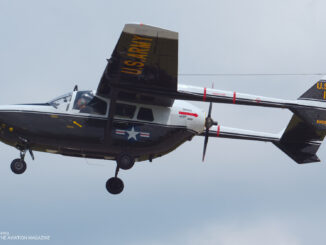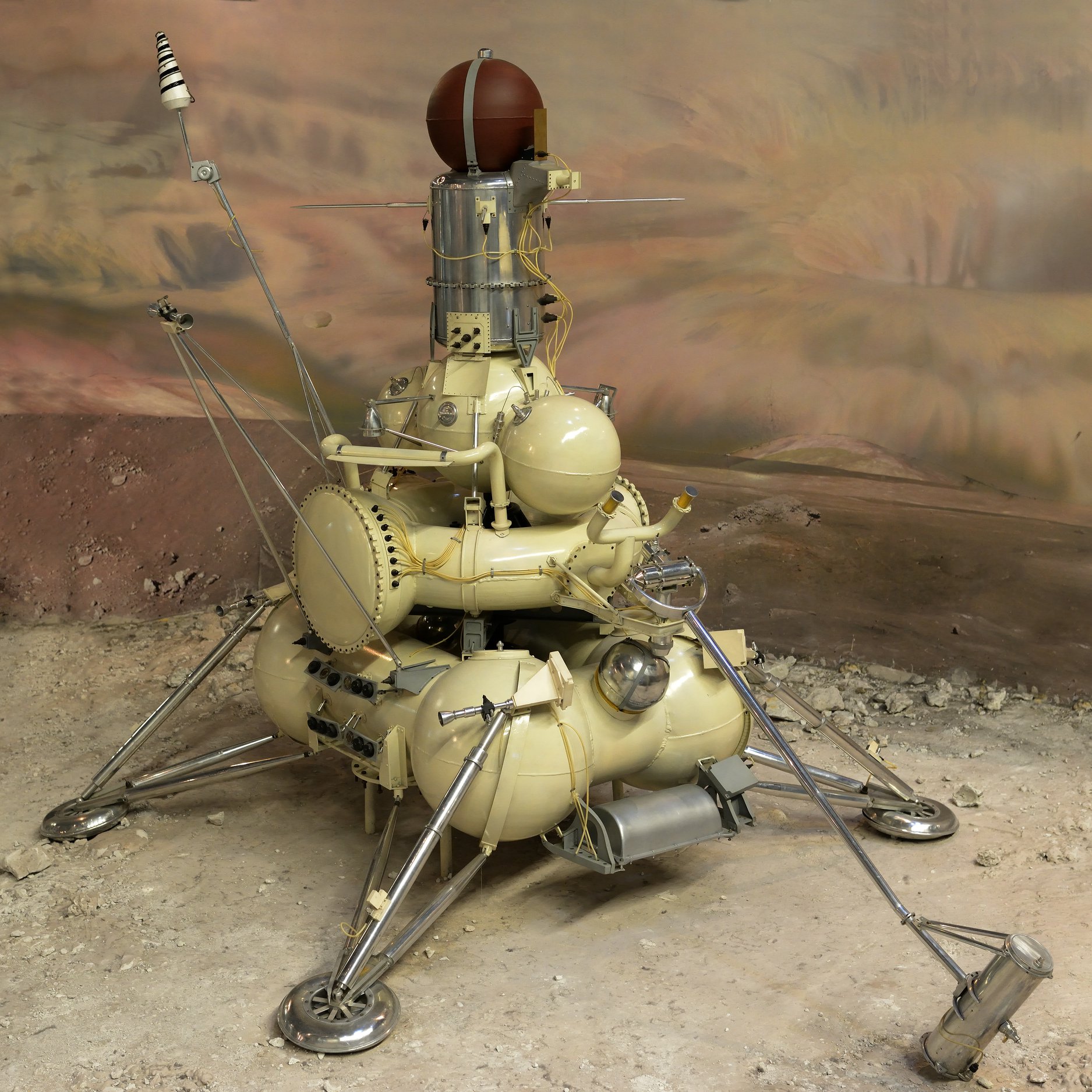 Tupolev Tu-104A (c/n 76600503, formerly OK-LDA, operated by Československé Aerolinie / Czechoslovak Airlines – ČSA), open-air exhibition in Kbely Aviation Museum, Prague (Letecké muzeum Kbely), April 2013.
Tupolev Tu-104A (c/n 76600503, formerly OK-LDA, operated by Československé Aerolinie / Czechoslovak Airlines – ČSA), open-air exhibition in Kbely Aviation Museum, Prague (Letecké muzeum Kbely), April 2013.
Since the early 1950s, the turbojet propulsion was no longer reserved only for military aircraft. Although some development began already shortly after the end of the Second World War, the new era in passenger aviation officially commenced in 1952. In that year, de Havilland Comet, the first purposedly built jet airliner, entered operational service with British Overseas Aviation Company.
Until the end of the decade, the Comet was followed by several other jet-powered passenger aeroplanes, such as Sud Aviation Caravelle (first flight on 27th May 1955), Boeing 707 (20th December 1957), Douglas DC-8 (30th May 1958) and Convair 880 (27th January 1959).
Those Western developments did not escape attention of the Soviet authorities. Already on 11th June 1954, the Soviet Council of Ministers issued the official resolution that assigned the task of creating the Soviet jet airliner to Tupolev construction bureau (OKB-156).
The Council of Ministers´ choice of Tupolev was not accidental. Two years earlier, OKB-156 began to develop the ´Aircraft N´ – a twin-engine, jet powered strategic heavy bomber with the company designation Tu-88. The aeroplane, later known as Tupolev Tu-16 (NATO reporting name ´Badger´) performed its maiden flight on 27th April 1952 and two years later entered operational service with the Soviet Air Force.
Initial sketches of passenger airliner based on the same concept as the Tu-88 were already done at OKB-156 at the early stage of development of the bomber aircraft. However, the works gained momentum only after the official approval of the Council of Ministers. The future Soviet jet airliner received the company designation Ту-2АМ-3-200 (Tu-2AM-3-200) but it soon became known under its national index Tu-104.
Several construction elements from the Tu-16 were adapted for the airliner, including wings, tail section and landing gear. The Tu-104 was also equipped with the same Mikulin AM-3 engines as used in the Tupolev strategic bomber. Engine nacelles, also taken from the Tu-16, were mounted in the wings, close to the aircraft fuselage. Although such design seems to be a bit unusual nowadays, it was common in the early years of the jet aviation and was shared also by other aircraft from the era, such as Avro Canada C102 Jetliner or the aforementioned de Havilland Comet.
One of the main design differences between those two jets was wing configuration. The Badger was a mid-wing monoplane, while the wings of the airliner were mounted much lower to the fuselage, making the Tu-104 a low-wing monoplane.
Thanks to combining both the Tu-16 and the Tu-104 developments, extensive use of the components from the strategic bomber, as well as drawing on the experiences from the Aircraft N programme, the development of the first Soviet passenger jetliner was going quite fast.
On 17th June of 1955, the Tu-104 performed its first flight. The first serial aeroplane was built already in November of the same year and, in September of 1956, the Tu-104 commence its first regular passenger service on Moscow – Omsk – Irkutsk route.
At that time, the Comet was plagued with structural issues which led to several fatal accidents. In consequence, the operational service of the world´s first passenger jet was suspended in 1954. The British airliner had to be significantly redeveloped and returned into service only in 1958. Therefore, between 1956 and 1958, the Tupolev Tu-104 was the only operational jet powered passenger aeroplane in the world.
Nevertheless, and similarly to the Comet and other first-generation jets, the operation of the Tu-104 was overrun by many construction and design flaws. The aeroplane was very demanding for its pilot, with poor response to controls and tendency to stall without any warning. Additionally, the jetliner required a high approach and landing speed of approximately 300 kph.
The high landing speed of the Tu-104 was a real problem and resulted in necessary extension of many existing runways at passenger airports, also outside the Soviet Union. Additionally, in order to shorten the landing roll, Tupolev equipped the jetliner with two drag parachutes.
Regrettably, also the Tu-104 safety index was low. According to Aviation Safety Network website, a total of thirty-seven first Soviet jetliners were lost in accidents, resulting in 1137 fatal casualties. In addition, three aeroplanes were hijacked with further 84 people killed.
The Tupolev Tu-104 was manufactured until 1960, when its production was finally ceased. There were a little more than 200 examples of the airliner built, in approximately twenty variants, including prototype and testbed aircraft. The initial version of the Tu-104 was able to carry up to 50 passengers but the fuselage was continually extended with later variants, until the Tu-104B-115 for up to 115 passengers.
The Soviet state airline Аэрофлот (Aeroflot) was the main operator of the Tu-104, about two dozen examples were used by different branches of the Soviet Armed Forces (including the aircraft assigned from Aeroflot). The only foreign customer for the Soviet jetliner was Czechoslovakia that acquired six aeroplanes for its national carrier Československé Aerolinie (Czechoslovak Airlines – ČSA). Although Wikipedia, and some other websites, mentions also the Mongolian Armed Forces as one of the Tu-104 operators, this information was not confirmed by available Russian sources.
ČSA acquired six jetliners with deliveries between 1957 and 1963. All of them were purchased in Tu-104A variant, able to carry up to 70 passengers. Five of them were new and one came from the Aeroflot inventory.
The Soviet airliner meant a great improvement to the ČSA service, despite the aforementioned issues with its operation. Shortly after the Czechoslovak carrier became known for being the only airline in the world that used only the jet-powered aeroplanes on long haul routes. Three ČSA aircraft were destroyed during service – two of them were damaged beyond repair in accidents and one lost in crash that occurred on 1st June 1960 in Tripoli, with thirteen fatal casualties.
An interesting fact is that the Czechoslovak Tu-104 were equipped with additional navigation equipment of the Western origin. Additionally, interior of the passenger cabin was redesigned.
The aircraft OK-LDA ´Praha´ (Prague) was delivered to ČSA in November of 1957 and was operated by the Czechoslovak Airlines until 1973. After its retirement, the jetliner was flown to Kbely airfield and then handed over to state-owned aviation museum located there.


